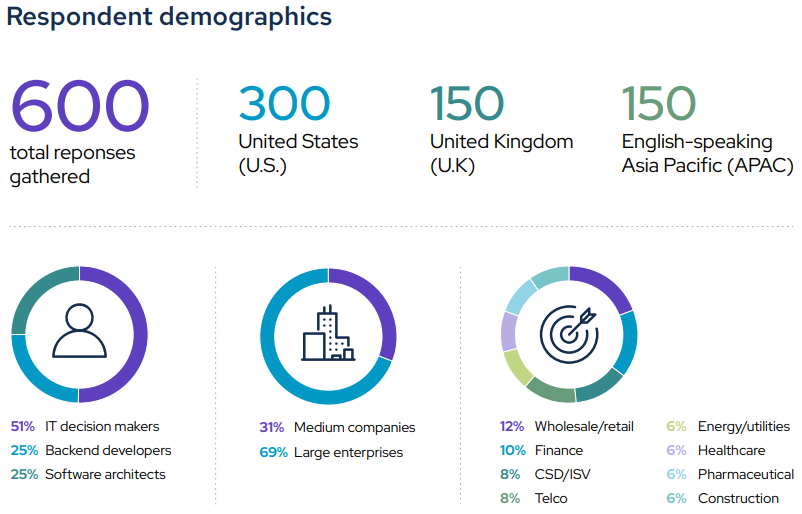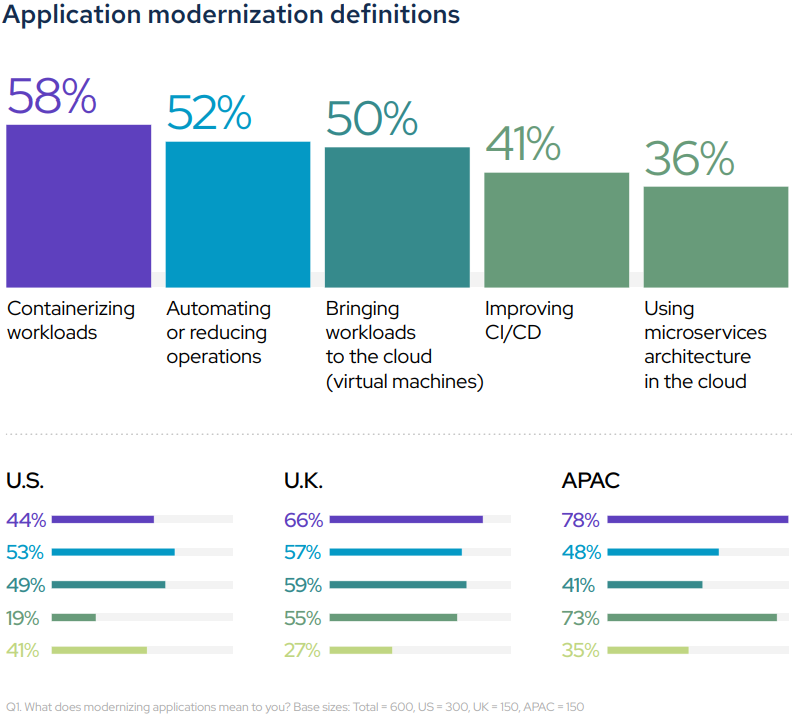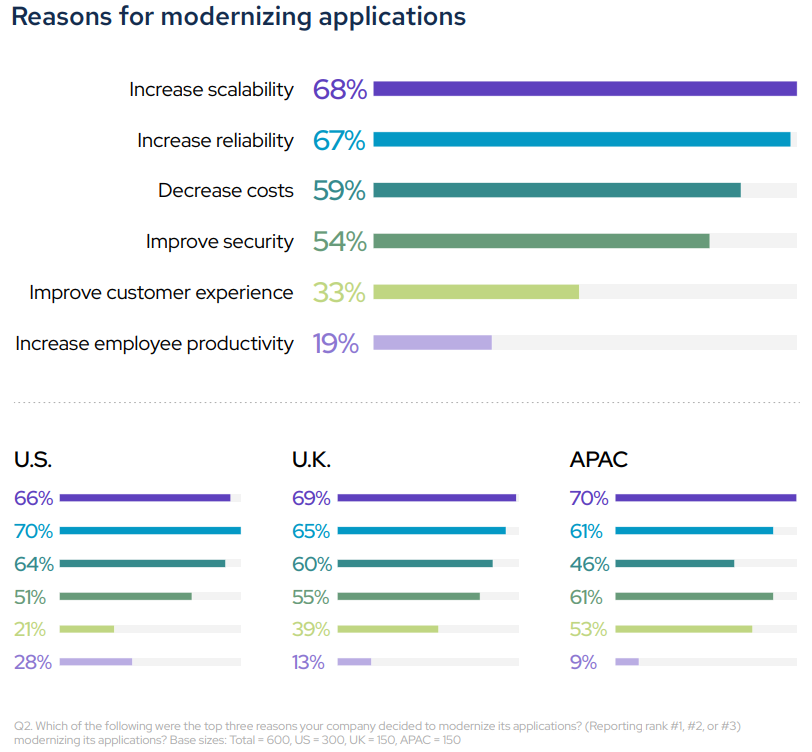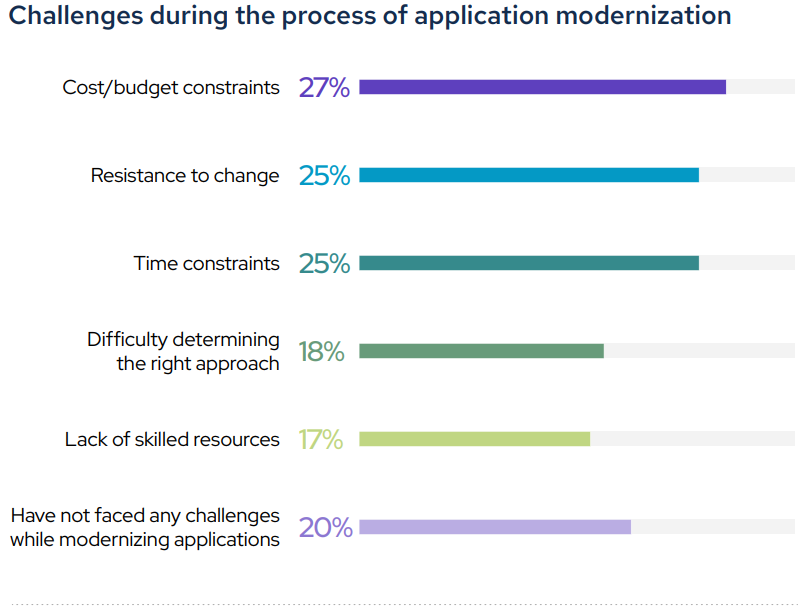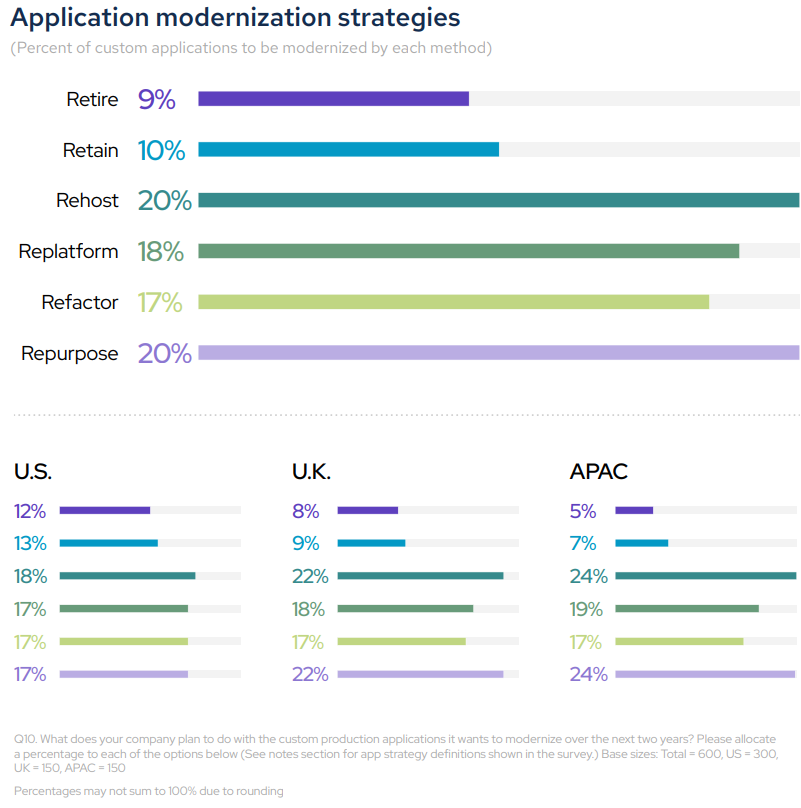How enterprises approach legacy application modernization
Executive summary: Businesses focus on application modernization
Across industries, applications continue to grow in importance. Both our customers and past surveys tell us that organizations are modernizing their applications to support business success. Even so, application modernization can mean many different things to different people. Definitions, approaches, and perceptions vary according to organizational structure, IT estate status, available technology, and past experiences, to name a few.
We wanted to learn more about the specifics of application modernization across organizations and regions. We asked IT decision makers, backend developers, and software architects about their application modernization priorities, challenges, and plans, and how they define success.
We found that people, processes, and technologies can greatly impact the success of your application modernization journey. Each of these areas appears in our survey results in various ways. For example, feelings of anxiety about the unknown show up as resistance to change — the top barrier to getting started with application modernization initiatives (Finding 4). Process challenges like taking on too much at once emerge as time and budget constraints that keep modernization projects from progressing smoothly (Finding 4). And technology considerations like portability, ease of use, and security come out as both drivers and definitions of application modernization (Findings 2 and 3).
As we explored the different angles of application modernization, we also learned that organizations are adapting their people, processes, and technology for success. They plan to engage external partners to help modernize the majority of their applications (Finding 5). They are tailoring their modernization strategy according to the needs of each application (Finding 6). And they are taking hybrid architectural approaches to maintain flexibility and reliability (Finding 9).
This report covers a lot of ground, but the overall message is clear: modernization is a priority for organizations across regions. Read on to discover 10 key findings from our survey.
About this report
Red Hat sponsored a survey of 600 IT decision makers (ITDMs), backend developers, and software architects in the United States (U.S.), the United Kingdom (U.K.), and the English-speaking Asia Pacific region (APAC) to understand how organizations plan to approach modernization and migration and how they define application modernization success. Data was gathered through 25-minute phone interviews with respondents sourced from third-party databases. The survey was conducted in October and November of 2021.
Respondent profile:
- IT decision makers, backend developers, or software architects responsible for their company’s application portfolio
- From companies that have an internal application development team and custom applications that they are modernizing or planning to modernize
- From companies that use or plan to use hybrid cloud or multicloud architectures, and currently use containers or Kubernetes
Key findings
Our survey generated a lot of insight into how organizations approach application modernization. Here are the highlights:
- Companies plan to modernize 78% of their custom applications within the next year.
- Application modernization describes many different initiatives, including containerizing workloads, automating or reducing operations, and bringing workloads into the cloud.
- Scalability and reliability are the two most cited reasons for both why companies modernize and how they plan to measure modernization success.
- Resistance to change and time constraints are the most common barriers to getting started with modernization. Cost and budget constraints become the biggest barrier during the modernization process.
- External partners will play key roles in 70% of application modernization journeys, either leading in-house teams or directly modernizing applications.
- Organizations expect to use a variety of modernization strategies in near-equal proportions. But when you consider that 90% of those who plan to refactor applications will replatform them as a first step, replatforming becomes the strategy that will be the most used.
- Companies plan to modernize core backend applications first.
- More companies expect to have artificial intelligence and machine learning (AI/ML) software, data caching tools, and high-performance computing (HPC) workloads in place in the next two years.
- Organizations expect to modernize the largest portion of their application portfolio using hybrid architectural approaches.
- Cloud services will replace key application elements, providing increased scalability and cost-effectiveness. For example, cloud provider committed spend programs allow organizations to purchase subscriptions for cloud platform software like Red Hat OpenShift. Committed spend programs optimize cloud budgets and simplify the procurement process, leading to cost and time savings.
Read on to discover more about these findings.
Finding 1: Organizations plan to modernize applications rapidly
Companies plan to modernize 52% of their custom applications within the next year.
We looked for respondents who were modernizing or planning to modernize their custom applications, so it was no surprise that everyone we surveyed is modernizing. Less expected was how quickly they are planning to do so. Companies aim to modernize more than half (52%) of their custom applications during the next year, and an additional quarter (26%) of their applications during the following year. They expect only 20% of applications to take more than 2 years to modernize.
This may seem optimistic, and developers were generally less confident than their ITDM and architect counterparts that modernization would be quick or straightforward. Even so, customers continue to bring up these timelines in conversations with increasing frequency. The pandemic clearly showed how critical innovation and agility are to business success, and modernization is at the core of these initiatives.
Actual modernization timelines will depend on many factors, including available budget, the type of application, how it was created originally, how it is deployed, and the number and complexity of dependencies that must be addressed. The level of modernization needed and the size of an organization’s application portfolio will also impact timelines. For example, modernizing Java applications will look different from efforts to update SAP workloads.
Several things can help organizations achieve their goals faster. Deploying a modern, cloud-native IT architecture prior to application modernization, following a proven methodology, and using the right migration tools can simplify and speed the process. And, once you start modernizing your applications, you can apply learnings to optimize your techniques. For example, you can validate your modernization process and tools on one application and use the knowledge and experience you’ve gained to modernize other similar applications at scale.
Finding 2: Modernization means several different things
Respondents define application modernization as containerizing workloads, automating or reducing operations, or bringing workloads to the cloud.
The term modernization is often used to describe a variety of initiatives and actions, so we asked respondents how they define application modernization. More than half of respondents cited containerizing workloads (58%), automating or reducing operations (52%), and bringing workloads to the cloud (50%) as key characteristics.
It was also interesting to see how the characteristics changed across regions. APAC organizations focused considerably more on containerizing workloads and improving continuous integration/continuous deployment (CI/CD) than any other region. U.S. respondents selected using microservices in the cloud more often than U.K. or APAC organizations. And U.K. respondents chose bringing workloads to the cloud by a higher margin than other regions.
To be successful, modernization must provide value to an organization. These survey results reflect the different ways organizations plan to gain value from their modernization efforts. While the specifics may different for each organization, it’s clear that modernization is more than a single action or definition.
78% Organizations surveyed plan to modernize nearly all of their custom applications in the next 2 years. Only 20% of custom applications will take more than 2 years to modernize.
Finding 3: Innovation is the primary motivator for modernization
Companies are modernizing their applications to increase reliability and scalability.
Next we wanted to understand the reasons that organizations are modernizing and how they plan to measure the success of their modernization efforts. As it happens, innovation — rather than cost — was key in both cases. Increasing reliability and scalability were cited as both top drivers and key success indicators for application modernization. Decreasing costs was the number three driver and number four success indicator overall, with roughly the same emphasis as improving security. As reliability, scalability, and security are fundamental to innovation, these results show that companies are more focused on transforming their services and business than on simply cutting costs.
As before, there were significant regional differences. APAC respondents ranked improving security as high as increasing scalability and reliability in both cases, while decreasing costs were a considerably higher concern for U.S. and U.K. respondents. Improving customer experiences was also a much higher priority for APAC respondents, especially compared with U.S. respondents.
Even so, each of the options in the survey are interconnected with others. For example, increased reliability, scalability, and security can support improved customer experiences and employee productivity. As a result, the regional differences we see may say more about the roles of individual respondents rather than the overall goals of their organizations. ITDMs may focus on business-level outcomes, while developers and architects may rank more tactical actions higher.
Finding 4: The top modernization barriers are familiar
Resistance to change and time and budget constraints are top barriers to both starting and moving forward with application modernization.
We asked respondents about two sets of challenges related to application modernization: barriers preventing them from getting started and obstacles that keep them from moving forward during the modernization process. Unsurprisingly, resistance to change, time constraints, and budget restrictions — common challenges for large IT projects — were cited as top barriers in both situations.
Resistance to change was the top barrier to getting started (32%) and number two challenge during the modernization process (25%). Resistance to change often correlates with a lack of skills or resources related to new technologies (20% and 17%, respectively), so training and skills development should also be prioritized with modernization efforts.
Time constraints — the number two barrier to getting started (28%) and progressing (tied with resistance to change at 25%) — are often related to larger challenges in connecting and aligning teams within organizations. Each team involved needs to have time to work on modernization projects at the same time as the others — scheduling and orchestration are critical.
Finally, budget constraints were the number three barrier to getting started (26%), but rose to number one during the modernization process (27%). Even so, the cost of continuing to maintain legacy applications — including software and support contracts, the ability to find staff with the right skills, and lost opportunity costs — often far exceeds modernization costs.
While any large IT project will face challenges, organizations can reduce the burden of these modernization barriers significantly by following best practices:
- Start with a thorough assessment of your application portfolio to find the most impactful opportunities.
- Make a compelling business case — including data, value, and vision — to get executive sponsorship and secure the resources needed to make and keep modernization a top priority.
- Build the right teams, align them to meet specific enterprise needs, and help them collaborate effectively to avoid redundant and unnecessary work.
- Constantly educate the teams who will use new technologies to help them understand how their role may change and how they will benefit.
Finding 5: External partners will help with modernization
Respondents expect external partners to be involved with modernizing their applications, either handling the process completely or leading in-house staff.
On average, only 31% of each organization’s applications will be completely modernized by in-house staff. The rest of their application portfolios will either be handled completely by external partners (30%) or modernized by in-house staff led by external partners (39%). Overall, this seems like a good mix for companies to be successful in the long term.
When working with external partners, it’s important to keep internal teams involved throughout the process. An internal team should own the overall project, working closely with and providing guidance to partner teams regarding enterprise constraints and needs. While an external partner can advise how to implement future-state technology, your internal teams possess the enterprise domain knowledge required to make decisions about the best way to use the new technology.
Without an internal counterpart to provide direction, there is a higher risk of external partners building software that cannot be used due to regulatory, operational, or organizational constraints. Partners may also need to spend a considerably greater amount of time learning about your portfolio and ways of working, increasing the cost, risk, and length of the project.
Finding 6: There is no single application modernization strategy
Companies intend to replatform, refactor, or repurchase about half of their custom applications.
In considering application modernization strategies, we presented survey respondents with six choices, the widely used 6Rs:
- Retire. Decommission applications that are no longer needed.
- Retain. Leave critical applications as-is until refactoring is required.
- Rehost. “Lift and shift” applications to a cloud with minimal changes.
- Replatform. Upgrade operating systems, databases, and other components as needed to allow applications to run in a cloud, without changing the core application code or architecture.
- Refactor. Rearchitect applications to be cloud-native by containerizing workloads or moving them to a serverless architecture, for example.
- Repurchase. Move from perpetual application licenses to a Software-as-a-Service (SaaS) model.
Each of these strategies will be used to some degree. Retire (9%) and retain (10%) were each about half as popular as the other options, each of which captured around 20% of the applications to be modernized. These results show that companies are selecting the modernization strategy that aligns best to each individual workload, rather than taking a single approach for all workloads across the organization.
The distribution of modernization strategies also varied by region and respondent role. Organizations in the U.K. and APAC region plan to rehost or repurchase a larger proportion of their applications than U.S. companies. Developers were more cautious in their intended approaches and were more likely to prefer rehosting strategies than more aggressive ones, compared to ITDMs and architects.
Finally, we found that refactoring — the most complicated modernization approach — is almost always a two-step process. 90% of organizations that plan to refactor legacy applications intend to replatform them first.
Finding 7: Core backend applications are a modernization priority
Organizations across regions plan to modernize core backend applications first.
Customers tell us that limited scalability and reliability of their existing core backend applications can restrict innovation within their companies. And issues with these critical applications can impact the entire organization.
So we weren’t surprised to see that core backend applications were the top priority for modernization across all regions. Data, analytics, and business intelligence (BI) applications were a close second priority for U.K. respondents, while customer-facing applications were a close second for APAC respondents.
When planning to modernize critical applications like these, it’s important to carefully assess and understand the dependencies associated with each application. Core applications often rely upon older, more static systems that may not work well with newer, more dynamic technologies and services. As a result, you may need to consider migrating or modernizing additional systems, data stores, and applications with your main core application.
Finding 8: AI/ML, data caching, and HPC workloads are growing
More companies expect to have AI/ML software, data caching tools, and HPC workloads in place in the next two years.
While traditional workloads like web servers, business process applications, and databases are currently the most common, they are not the fastest growing. In fact, our survey respondents expect artificial intelligence and machine learning (AI/ML), data caching, and high-performance computing (HPC) workloads to grow much faster in the coming years. Companies anticipate their use of these workloads to grow by 6-17% over the next 24 months, compared to -5% to 3% for more traditional workloads, depending on which region you look at. For example, each of these workloads show the highest increases in U.S. companies. Analytics workloads fall in between the two groups in both overall current level of use (77%) and expected growth (5%).
AI/ML, data caching, and HPC workloads are interconnected, so it’s not surprising that they are growing at similar rates. Data caching supports demanding workloads like AI/ML software and HPC tasks by reducing the amount of work needed to find, transfer, and process data.
These survey results also indicate that now is the time to begin establishing and deepening your skills in these emerging areas, as this will be where most new application development occurs.
Finding 9: Hybrid architectural approaches are preferred
Companies expect the largest portion of their customer applications to be modified towards a hybrid architectural approach.
Respondents report that 41% of their custom applications will be modified toward a hybrid architecture approach. 33% are expected to move toward a serverless or Function-as-a-Service (FaaS) approach, and 27% will take a microservices approach. And unlike several other survey questions, these percentages were remarkably consistent across regions.
This may indicate the relative stability and maturity of hybrid approaches — organizations are likely less familiar and comfortable with microservices, serverless, and FaaS approaches. And hybrid approaches may simply be the best option for the majority of applications that companies plan to modernize. For example, the cost of rearchitecting applications with a small number of users or limited scale may actually be more than the benefits that a microservices or serverless architecture provides. The ultimate goal should be to choose the architecture that delivers the best return on investment for each application.
Finding 10: Cloud services will replace the most common element in custom applications
Integration is the most common element in custom applications, and many intend to repurchase or replace it with cloud services over the next two years.
Finally, we wanted to understand how organizations plan to incorporate cloud services into their applications. We asked respondents about the elements they currently use in their applications and which they expect to replace with cloud services in the near future.
Integration (53%), data streaming (40%), and AI/ML services (36%) were the most common elements used in custom applications. For those companies using each element in their applications, authentication/authorization (66%), integration (46%), and event processing (45%) were the elements most expected to be replaced with cloud services in the next two years.
These results make sense — integration, event processing, authentication, and authorization can be difficult and costly to scale in-house, making them ideal candidates for flexible, scalable, managed cloud services. And these three elements will likely only grow in use as applications become more connected and consume greater amounts of data. Replacing these elements with a cloud service can increase scalability, flexibility, and reliability while reducing overall costs.
Additionally, as security threats continue to grow, authentication and authorization elements become increasingly critical. Many organizations are adopting zero trust approaches, which require strong, scalable, and connected identity and access management systems. Cloud services for authentication and authorization can help you build a more comprehensive identity management system to support zero trust architectures and improve overall security.
Learn more
Application modernization is a clear priority for organizations across industries and regions.
Even so, the process can be daunting and requires detailed planning, time, and resources. As a result, application modernization is an ongoing journey for most organizations. Following these best practices can help you modernize more quickly and successfully:
Assess your portfolio
Begin by assessing your application portfolio to find the most impactful opportunities.
Blog post: Define your project scope
Online tool: Modernization assessment
Enlist your leadership
Secure executive sponsorship and project resources with a compelling business case.
Blog post: Make a business case
Article: Migrating 3,000 applications
Build your teams
Assemble collaborative project teams and align them to meet your enterprise needs.
Blog post: Build the right project team
Tool: Migration Toolkit for Applications
Educate stakeholders
Provide training, tools, and resources to teams who will use new technologies.
Blog post: Prepare your team
Community: Konveyor

